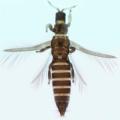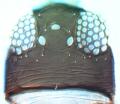Stenchaetothrips biformis
Recognition data
Distinguishing features
Female macropterous; body colour brown to dark brown, tarsi and fore tibiae paler; antennal segments III and apex of II yellow, IV light brown, V–VII brown; fore wings light brown, clavus darker. Antennae 7-segmented, III & IV with short forked sensorium. Head about as long as wide or slightly longer, without sculpture between ocelli; 2 pairs of ocellar setae present, pair III shorter than II and arising just anterior to hind ocelli; postocular setae variable, pair II as long as distance between hind ocelli. Pronotum with 2 pairs of long posteroangular setae; posterior margin with 2 or 3 pairs of setae. Metanotum longitudinally striate with striae converging posteromedially; campaniform sensilla absent, median setae arising behind anterior margin. Fore wing first vein with 2 to 4 setae on distal half; second vein with complete row of about 12 setae. Tergites II–VIII with no sculpture medially, median setae small and wide apart; V–VIII with paired ctenidia laterally, on VIII posteromesad to spiracle; posteromarginal comb complete with irregular slender microtrichia. Sternites without discal setae, posterior margins with irregular, small dentate microtrichia; sternites IV–VI sometimes with small and poorly developed pore plate medially; setae S1 on sternite VII arising just in front of margin.
Male similar to female but smaller; posterior margin of tergites II–VII with small, laterally pointing teeth, VIII with similar teeth arranged irregularly; sternites frequently bearing many discal microtrichia, posterior margins with irregular dentate microtrichia, III–VII with transverse pore plate.
Related and similar species
Currently, 32 species are listed in the genus Stenchaetothrips, all associated with Poaceae and all originally from the Old World tropics (Mound 2011). S. minutus is particularly similar to S. biformis, but has the basal half of antennal segment VI yellow in contrast to almost entirely brown. The genus is closely related to the genus Thrips, but the pair of setae on the head anterolateral to the fore ocellus (pair II) are much longer than the pair of interocellar setae (pair III).
Taxonomic data
Current valid name
Stenchaetothrips biformis (Bagnall)
Original name and synonyms
- Bagnallia biformis Bagnall, 1913: 237
- Bagnallia biformis adusta Bagnall, 1913: 238
- Bagnallia biformis melanurus Bagnall, 1913: 238
- Thrips (Bagnallia) oryzae Williams, 1916: 353
- Thrips holorphnus Karny, 1925: 15
- Plesiothrips o Girault, 1929: 1
- Chloethrips oryzae (Williams); Priesner, 1957: 162
- Thrips dobrogensis Knechtel, 1964: 479
- Chloethrips blandus zur Strassen, 1975: 78
Family placement
Thripidae, Thripinae
Common names
Rice thrips
Biological data
Life history
Breeding on the young leaves of Poaceae in damp places. Eggs are laid on the lower surface of the youngest leaf, and larvae feed within this rolled leaf. Pupation occurs on the plant, and the period from egg to adult varies between 14 and 21 days (Nugaliyadde & Heinrichs, 1984).
Host plants
Various species of Poaceae in damp places, particularly seedlings of rice, Oryza sativa.
Tospoviruses vectored
None
Crop damage
Damaging young leaves of irrigated rice.
Distribution data
Area of origin
Probably from the warmer parts of Eurasia.
Distribution
Widespread across the warmer parts of the Old World, from Europe to northern Australia, and introduced to Colombia, Guyana and Surinam. A potential invader to California.






